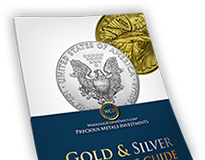- Gold $0.00 $0.00
- Silver $0.00 $0.00
- Platinum $0.00 $0.00
- Palladium $0.00 $0.00
Pricing:
| QUANTITY | E-CHECK/WIRE | CREDIT CARD |
|---|---|---|
| Any | $76.47 | $79.66 |

Get Our Free
Gold & Silver
Investor's
Guide
Description:
The silver dollar coin known by history as the Morgan dollar returned to production in 1921, not far off two decades after this dollar had last been made. However, the Morgan dollar was, months later, succeeded by a new silver dollar, the Peace dollar - so-called as it memorialized peace. That is the peace that had emerged in World War I's wake. A peace-memorializing coin had been lobbied for by numismatists, who succeeded in persuading government officials to bring such a coin into reality. The Peace dollar had similarities and differences to the Morgan dollar in design.
While a left-facing Liberty was depicted on each obverse, the Morgan dollar's portrayal of teacher Anna Willess Williams as Liberty gave way to the new coin's image of Teresa de Francisci, the designer Anthony de Francisci's wife, as the highly symbolic goddess instead. Similarly, while the previous coin had shown an eagle flying, the Peace dollar pictured an eagle perched with closed wings. Before production commenced, a broken sword was also set to feature on the coin's eagle side. However, that weapon was quickly removed after complaints that it looked symbolic of defeat. This damaged sword did not appear on any minted Peace dollars.
What will appear, however, beneath the Liberty likeness is a common date. This date commonly appears on Peace dollars that are still seen today. That date is particularly likely to be 1922 and 1923, as those dates are the most common on today's Peace dollars. Such dollars from the mid-1920s can also be seen relatively often. The Peace dollar was made year after year until 1928 when the last remaining Pittman Act silver was turned into coins - though this dollar was also made in 1934 and 1935.
Congress had passed an act whereby the U.S. Mint needed to lift silver producers by buying domestic silver in significant quantities. Across the two years, more than seven million Peace silver dollars were made. By 1936, commercial demand for silver dollars was nonexistent; therefore, no such dollars were struck in that year, even though working dies had been prepared. No Peace dollar mintages are considered rare today. Nevertheless, the task of collecting Peace dollars can still have a more forgiving start when the more common mintages are focused on first. This helps clarify why acquiring common date Peace dollars from our stock can benefit you.
It bears emphasizing that our stock of MS63-quality Peace dollars specifically is never guaranteed to be buoyant or even, in any fashion, present. It could, therefore, be good practice for you to put this page in your web browser's bookmarks; regularly checking the stock can, thus, become easier. There is particularly good reason to seek an MS63 coin. This grade is what many collectors deem the highest in numismatic collectability. The coin's strike should meet at least an average standard, as should the eye appeal. However, the piece's price will probably stay reasonable compared to how much you would have to pay for Peace dollars that are even better in condition.
Features of the Common Date $1 Peace Silver Dollar MS63:
- Only minimal distracting marks
- Portrayal of a beautiful Liberty with flowing hair
- Weight recordable as 412.5gr or 26.73g
Orders placed for products, not a specific year, will be fulfilled with coins of any date, based on availability. Orders of multiple coins may be filled with the same year or a variety of years.
Specifications:
| Product Type | Coin |
|---|---|
| Coin Series | Pre-64 Silver |
| Purity | 90% |
| Mint/Refinery | U.S. Mint |
| Metal Type | Silver |
| Face Value | $1 |
| Grade | MS63 |
| Coin Type | Certified |
| Modern or Historical | Pre-64 |
| Grade Service | NGC |
| Year | Varies |
| Metal Weight | 0.7734 troy oz |







